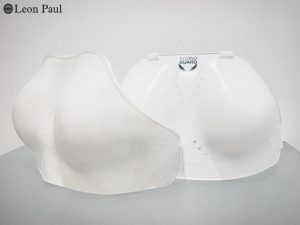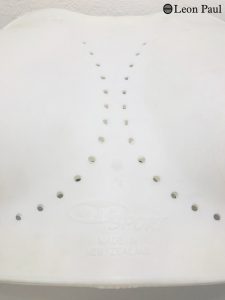We use cookies
Using our site means you agree to the use of cookies and similar technologies. Read about our policy and how to disable them here
The FIE recently has released new requirements for chest protectors both in men’s and women’s foil. For full information about the underlying problems (including a bit of foil history) as well as some instructions on what to do now and where to purchase, please read on...
The chest protector – a nondescript bit of fencing gear?
What’s there to say (let alone to write a blog post) about chest protectors? At first glance, this piece of kit doesn’t offer much room for conversation: it is a simple, plain white plastic mould secured by three straps (one at the back, two above the shoulders), which lives most of his life hidden under layers of clothing. Its main component, polyethene, can't be considered a revolutionary material with a halo of the extraordinary. And according to FIE rules, the chest protector is mandatory only for female fencers, which makes it – so it would seem – a subject leaving out at least half of the fencing crowd from the start. So, chapter closed? Well no, not really. At least if you’re a Foil fencer, read on.
A bit of (fencing) history
Despite simple appearances, the chest protector has been an issue raising controversy amongst fencers and officials for almost a decade now. In order to fully understand the extent of the problem (and the recent solution the FIE has come up with), we need to have a glimpse into the history of fencing and go back to the year 2005. It was at that time that an apparently minute, yet incredibly significant change took place in foil fencing. After a short trial period, the FIE changed the timings, by increasing the contact time (that is, the time your foil tip needs to be depressed against the target area before your light comes on) from 1-5 milliseconds to 13-15 milliseconds. Although this is a change that is virtually imperceptible to the eye, it had a huge impact on the practice of foil fencing: as a whole generation of foil fencers raised under the old rules found out (sometimes at their expense), some actions were now much harder to execute or even bound to fail. For instance, an expeditious flick to the flank preceded maybe by a swift coupé, which before almost guaranteed you a valid hit, now just wouldn’t work anymore due to insufficient contact time. But, as some all too wily fencers soon found out, there was a way – and that’s where the chest-protector comes in – you could use this change in contact times to your (unfair) advantage: A strong hit against a very hard and possibly even surface, in fact, would cause the foil point to bounce off before the contact time necessary to provoke a light was reached. In other words: with the new timings, you could trick the machine into not registering an actual valid hit. And how did you manage to present a possibly “bouncy” target to your opponent? Yes, by wearing a chest protector. The irony of the fencing gods, this way of cheating the scoring machine would work particularly well in men’s foil, as, contrary to the rounded shape of women’s chest protectors, the flat and even surface of men’s plates proved particularly beneficial for the (unsporting) deflection of hits. This is why 2005 saw a sudden boom in sales of chest protectors for male (foil) fencers, who sometimes would even wear their newly acquired carapace directly under their lame. The FIE (and along with them, most national fencing federations) reacted quickly, updating their rules so that the chest protector, at least in foil, is worn under the plastron.
Take section m.25.4.c of the FIE rulebook, for instance:
“At all weapons, the use of a breast/chest protector (made of metal or some rigid material) is compulsory for women and optional for men. At foil, this breast/chest protector must be worn below the protective plastron.“
This update to the rules arranged things a bit, as fencers now were as a matter of fact obliged to wear their chest protector under three layers of cloth (plastron, fencing jacket and lame), which would act as a buffer and thus diminish the ‘bounciness’ of even the hardest chest protector. Peer pressure (“If you fence with a chest protector, I’ll fence with one, too. Or we can both take it off”) did the rest to contain the phenomenon of men wearing chest protectors.
But the general problem remained, both in men’s and (to a lesser extent) in women’s foil: under certain circumstances and hitting angles, the scoring machine was still prone to behaving erratically when a chest protector was involved. Even more so as the problem of chest protectors was actually double (as everyone who has ever done point control exercises against a partner wearing a chest plate will easily understand): in fact, when hitting against a chest protector, the foil tip was not only at risk to bounce back from the rigid plate, it could also simply slide across it and end up on off target on the opponent’s arm. Frankly not cool in a real match... And this problem became more acute with the emergence and propagation of lightweight foil vests with their smooth, and almost slippery surface, which presented less resistance to a sliding foil tip.
So, what could there be done? Taking the chest protector out of (foil) fencing, in general, wasn’t an option, for obvious safety concerns. But also banning it from only men’s foil was no viable alternative, as there was indeed a small portion of male fencers, especially among the veterans, who simply had to wear a chest protector for medical reasons. Requiring them all to furnish an official certificate stating their condition would not only have been a violation of privacy as well as a giant waste of time but would probably also have entailed the risk of placing all the respective fencers under the general suspicion of unsportsmanlike conduct. A more consistent solution had to be arrived at. One that would really get to the root of the problem, which was actually not the breast protector itself, but its rigidity.
Back to today: The new rules of the FIE regarding chest protectors
And with this, we are back in the present…or rather at the end of 2017, when the FIE adopted an important decision on this topic:
The updated section of m.25.4.c of the FIE rulebook now reads as follows:"At foil, the protector will have the following characteristics: The entire outside of the chest protector (the side facing the opponent) must be covered with a soft material such as E.V.A. (Ethylene vinyl acetate) of four mm thickness and density of 22kg/m3. (The material can be attached to the current plastic models or incorporated into the manufacture of new chest protectors). The material must have the SEMI technical mark at the centre of the upper edge."
Sum up – the new rules in a nutshell
If you’re a foil fencer (male or female) wearing a chest protector and want to participate in official FIE competitions, starting from this year’s Cadet and Junior World Championships in Verona, you’ll have to update your chest protector by attaching a soft cover meeting the requirements specified above to it.
Some pictures of the prototype version from QP Sports: [caption id="attachment_1106" align="alignnone" width="300"] Comparison Image, sample cover in front of an original chest protector[/caption]
[caption id="attachment_1105" align="alignnone" width="225"]
Comparison Image, sample cover in front of an original chest protector[/caption]
[caption id="attachment_1105" align="alignnone" width="225"] Close up of the sample rubber cover[/caption]
Close up of the sample rubber cover[/caption]
Leon Paul will begin selling the FoilGuard at our sales booth at Cadets and Junior World Championships in Verona and subsequently make it available on the worldwide websites once the product is in stock in sufficient quantities to meet demand. We’ll keep you posted right here and on our social networks to make sure you won’t miss anything!

